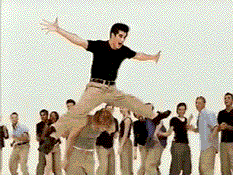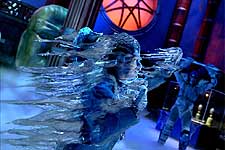Spotlight : June 1998
Bedtime For Deadtime
Written By Owen Hammer
Spotlight : June 1998
Bedtime For Deadtime
Written By Owen Hammer
|
Important Corrections
Firstly, "Reel FX" was incorrectly represented as "West FX." This has been corrected in the article. Secondly, the GAP ad did not use a multiple-exposure technique to create the frozen time effect. The ad was photographed with two motion picture cameras, with no physical cameras set up in an array. The in-betweening was done digitally by Buf Compagnie, post=supervised by Chris Morrison, via a software solution. VFX HQ regrets these errors. |
Yes, I know, right now it's the hippest, coolest, most outrageous
thing in visual effects. Yes, I know, it's catching on like wild-fire. Yes, I saw NBC's "Merlin." It's an ancient, romantic, heroic myth,
yet it had fewer weddings and pregnancies than anything NBC broadcast this
year.
 A frame from Dayton Taylor's Samsung commerical, where the camera dollys across the ground as people and objects are frozen in time. Check out a Quicktime movie of this and other commercials created by Taylor at http://www.virtualcamera.com.
A frame from Dayton Taylor's Samsung commerical, where the camera dollys across the ground as people and objects are frozen in time. Check out a Quicktime movie of this and other commercials created by Taylor at http://www.virtualcamera.com.
|
A deadtime shot is without precedent. A freeze-frame provides the audience with something they've seen before. We've all seen photographs-- so a still image is nothing spectacular. In fact, still photography outdates motion picture photography, otherwise people would be finding second gunmen in the Lincoln assassination footage. Deadtime allows us to see something we've never seen before--still time from multiple angles. We get a real 3-D view of still time.
The best use of deadtime involves footage of ephemeral phenomenon. Spray paint, hair flowing, people and objects in mid-air. The "mid-air" shot is the keystone of deadtime artistry. What good is a deadtime shot of a person just standing there? That could be just a mannequin. But no model-maker or cgi artist can capture the reality of flowing matter like deadtime photography.
How Is It Done?
I was fortunate to get in touch with two people who have created the
deadtime effect: Dayton Taylor and Ben Stokes.
Taylor patented his TimeTrack system in 1994 and is credited with the invention of the process. For more information, his web site has downloadable demo clips, and schematics of the patented system. Stokes, co-owner Chicago's premier indy production/post-production/graphics lab H-GUN, has used his own jury-rigged systems in the unforgettable Meat Beat
 The popular Gap television commercial, where a group of swing dancers appear to freeze in mid-air. To download a Quicktime movie of the commericial, click here.
The popular Gap television commercial, where a group of swing dancers appear to freeze in mid-air. To download a Quicktime movie of the commericial, click here.
|
The deadtime process is elegantly simple. A series of still cameras are place in a line, or an arc. This path is similar to the path a camera would follow in a moving camera shot. During the action, all the cameras are fired simultaneously. Then, the shots from these cameras are played back as a sequence. The result is a moving shot of non-moving time.
But there's more. Those of you who saw the Gap ad, which is everyone by now, saw time move, stop, and then start again. Please read the correction to this paragraph. To create the deadtime effect, one must have two motion picture cameras with a chain of still cameras between them. The two motion picture cameras are synchronized, and when the still cameras are fired, they take shots at 24 frames/second during the action. In editing, you pick a single point where you want the move to happen, and then cut from camera 1, to the analogous sequence of still pictures (remember, still cameras fire multiple shots, so you can choose where to have the "freezing point" in post), and then to camera 2, which should connect up to the sequence.
There's still more. Stokes predicts, deadtime will become a viable alternative to motion control systems, wherein the still cameras takes shots sequentially rather than simultaneously. Taylor lists multiple variations that are possible, and has used his system with a motion control pass for a Samsung commercial. Using deadtime footage as a launching point, not as a means to an end, is the secret to keeping the art alive.
Hey wait a minute!
Isn't that what I saw in BATMAN & ROBIN
and LOST IN SPACE? No. The freezing sequences in those movies used a much more
complex method which Taylor calls "photogrammetry." Warner Digital's Joel
Merritt explained the process used in BATMAN & ROBIN.
Basically three cameras capture the action, the middle camera takes the footage that's actually used in the print, and the other two take reference footage. Prior to this, the cameras shoot a series of 24 frame/second LED lights, and a laser marks the relative positions of the cameras. With all this information, and the actual footage from the cameras, cgi models are made. LOST IN SPACE used a similar approach, utilizing photogrammetry technique.
In the case of BATMAN & ROBIN, the use of photogrammetry was a conscious one. Taylor had approached the effects supervisors of the film to use his system, but they were sold on photogrammetry. Taylor concedes that his system is best used when TIME stops, not when SUBJECTS stop.
 A frame from the freezing sequence in BATMAN & ROBIN. The camera rotated around characters just as they became frozen. For a complete visual effects review of the film, click here.
A frame from the freezing sequence in BATMAN & ROBIN. The camera rotated around characters just as they became frozen. For a complete visual effects review of the film, click here.
|
Yes you read that right. They saw film as a set of frames so inherently connected as to be an inseparable whole. You can composite stuff, but that just changes what's on the film -- it's still film. You can edit, but all you do is change the duration of a length of film, and connect it to other pieces of film.
Thinking of motion picture footage as a frame based entity, completely divorced from reality's unattainable level of temporal consistency is a mind-set of the digital era. Virtual Reality, Quicktime, Quicktime VR, and seeing your footage as numbered files on a computer screen have changed our idea of how to acquire.
In fact, the word 'acquire' (in this context) didn't even exist seven years. You shot film. Acquisition was a given. Veteran cinematographers are stilled pissed off by this word: "Acquire? What am I, Indiana Jones?"
Questions...
How long is it before the use of deadtime becomes as cliche as the use of morphing?
Morphing was breakthrough technology once; now you can get morphing
software from a box of Cracker Jacks. I think the crappy dead-time
shot is just waiting to flash before my eyes.
"Does bad credit make you feel like your . . . FROZEN IN TIME?" "Our prices are so low they'll make you . . . STOP IN YOUR TRACKS." "Does microwave pizza make you feel a little . . . FROZEN?"
Taylor is more optimistic, saying he sees storyboards for many spots that are good, and would use the technology superbly, but simply never get produced. He says there are two people using it, the "just do it" crowd, perhaps the descendants of the morph-crazed tribes of the early nineties, and the people genuinely interested in the art form, of which Taylor counts himself.
Stokes has a similar view, citing that once the novelty wears off, it will simply become another option for the filmmaker. He likens it to the introduction of zoom lens in the 1960's, and those who have seen the
|
"Perhaps use of dead-time will
be rare and carefully considered." |
I take it one step further. The use of a zoom lens in today's Hollywood films to actually zoom in during a shot is very rare. Look closely, most of the time it's a dolly move, or the camera is on a jib arm. If you're doing a parody of bad martial arts films, you use a zoom lens. The use of a zoom lens makes your film look old and outdated. Is this the future of dead-time?
There is a big difference between dead-time and morphing. Morphing is software based, and software gets exponentially cheaper with time, so it became easier and easier to "get morph." Dead-time involves non-digital hardware that seems pretty stable in price. Perhaps use of dead-time will be rare and carefully considered given this restriction. However, in an industry where money is used up faster than toilet paper, I must stick to my original prediction.
Owen Hammer also wrote the Spotlight articles Why Morph?, Photo Op and The Deal.
Back to the Spotlight Main Menu

. . VFX HQ Produced by Todd Vaziri . . http://www.vfxhq.com . . e-mail: tvaziri@gmail.com . .
All text Copyright © 1998 Todd Vaziri, unless otherwise noted